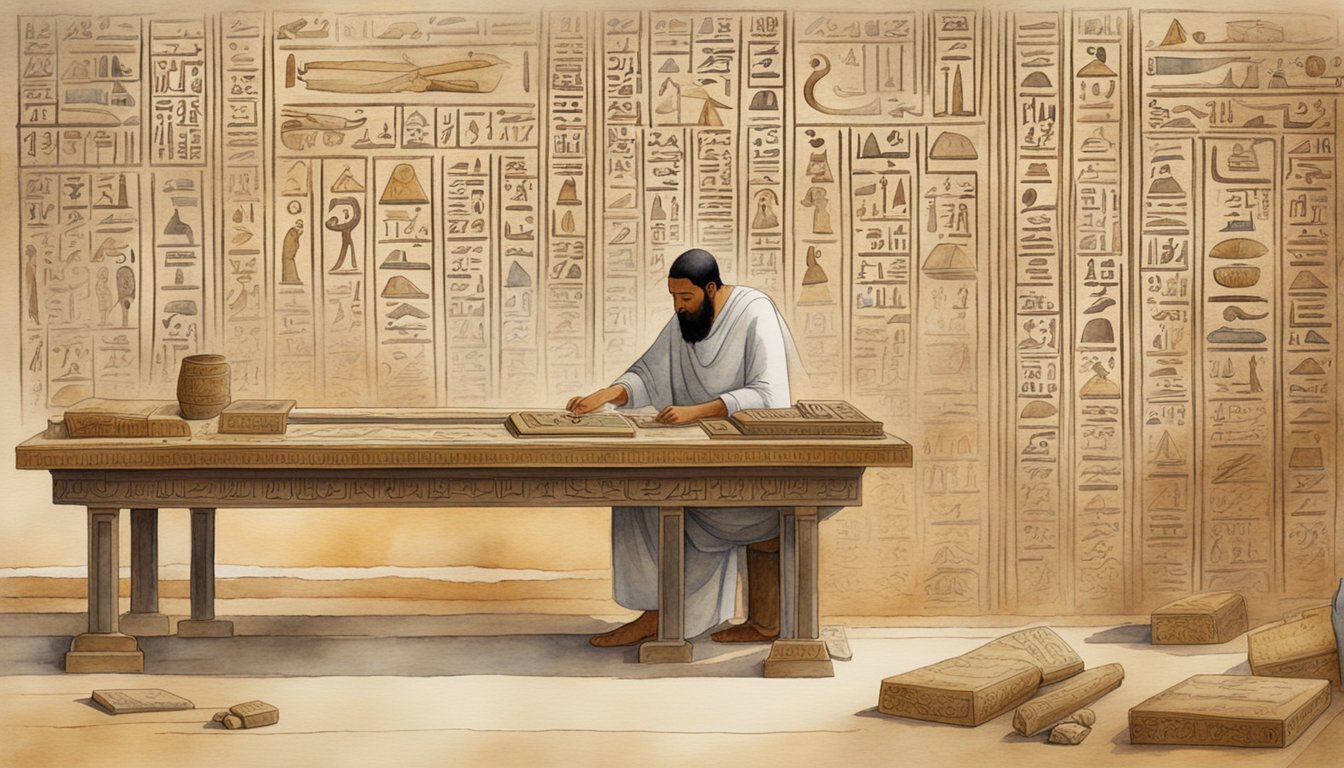Origins and Evolution of Hieroglyphics
Ancient Roots of Writing
Ancient Egypt is well-known for its unique hieroglyphic writing system. However, the concept of the written word was first developed in Mesopotamia and may have come to Egypt through trade interactions. During the time of the Predynastic Period and the Naqada III era, around 3000 BC, the early Egyptians started developing their own system of writing.
Transition from Proto-Writing
Initially, Egyptians used a form of proto-writing with symbols inscribed on pottery and other objects. This gradually evolved into the Egyptian hieroglyphic script, which became more sophisticated with time. The first monumental inscriptions appeared during the First Dynasty, reflecting advancements in the usage and function of hieroglyphs in different contexts.
Hieroglyphs and Their Semantics
Egyptian hieroglyphs combined logographic, syllabic, and alphabetic elements. In language terms, there were three types of hieroglyphs: ideograms, phonograms, and determinatives. Ideograms represented ideas or concepts, phonograms were signs corresponding to specific sounds or groups of sounds, and determinatives were signs that identified or clarified the meaning of certain words or phrases. The script is deeply rooted in how the ancient Egyptians perceived their world and nature.
Hieratic, Demotic, and Coptic Development
As hieroglyphs evolved, so did other forms of Egyptian writing emerged. Hieratic was a cursive version of hieroglyphs used for religious literature on papyrus and wood, mainly by priests and scribes. This system eventually led to the creation of the Demotic script, a more simplified form of writing used for everyday purposes and administrative tasks. Later on, the Coptic script developed, which was created by adapting the Greek alphabet and incorporating a few additional consonants.
The Egyptians believed that writing was invented by their god Thoth and referred to hieroglyphs as the words of the gods. The term “hieroglyph” is a Greek translation, meaning “sacred carving,” a fitting term for this ancient and intricate writing system that has intrigued scholars and enthusiasts for centuries.
Decipherment and Significance of Hieroglyphics

The Rosetta Stone Breakthrough
The Rosetta Stone, discovered in 1799, is a crucial artifact in understanding hieroglyphics, as it featured the same text written in three scripts: hieroglyphic, demotic, and ancient Greek. This allowed experts to compare and translate the various scripts, eventually leading to the decipherment of hieroglyphics1. The Rosetta Stone dates back to the Ptolemaic Period, and its inscription honored King Ptolemy V2.
Key Figures in Decipherment
Two major figures played a significant role in deciphering hieroglyphics: Thomas Young, an English polymath, made initial progress in understanding the script3. However, it was Jean-François Champollion, a French scholar, who made the largest strides in deciphering hieroglyphics4. Champollion’s work, Précis du système hiéroglyphique des anciens Égyptiens, laid the foundation for understanding these ancient texts5.
Impact on Understanding Ancient History
The decipherment of hieroglyphics revolutionized the study of ancient Egypt, providing invaluable insights into its history, religion, and culture. For instance, the Narmer Palette, an artifact dating back to 3200 BC, showcases the development of hieroglyphic writing and offers a glimpse into the unification of Upper and Lower Egypt6.
Hieroglyphics also shed light on the religious practices of ancient Egyptians. Texts such as the Book of the Dead presented detailed information about their beliefs and rituals, which were performed to ensure a successful passage to the afterlife7.
Hieroglyphs in the Modern World
Although hieroglyphs fell out of use after the Roman period, they still hold a significant place in modern culture. Many Egyptian monuments and temples still bear these intricate carvings, inspiring awe and curiosity among visitors. Today, hieroglyphics continue to captivate artists, linguists, and historians alike, serving as both a fascinating subject of study and a testament to the enduring impact of ancient Egypt.

